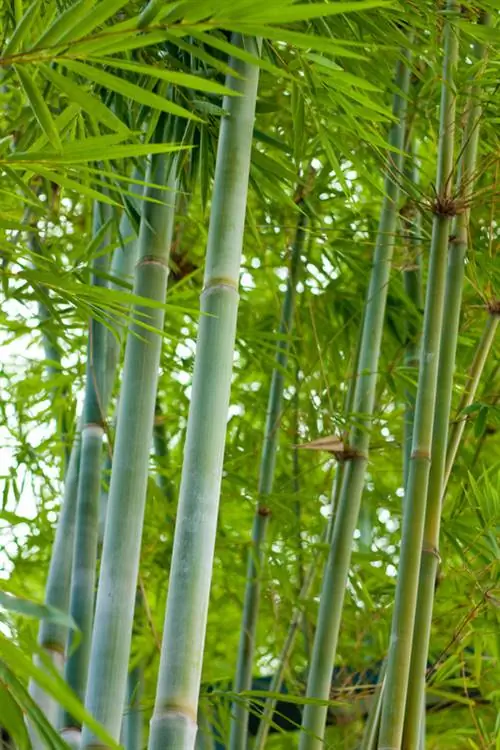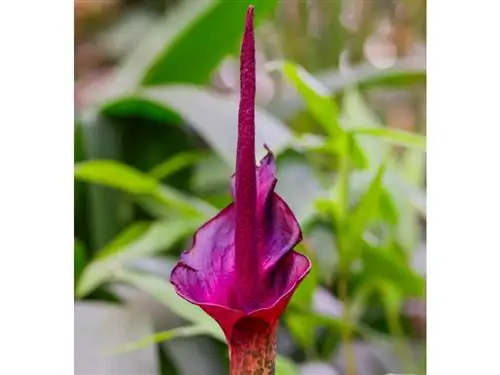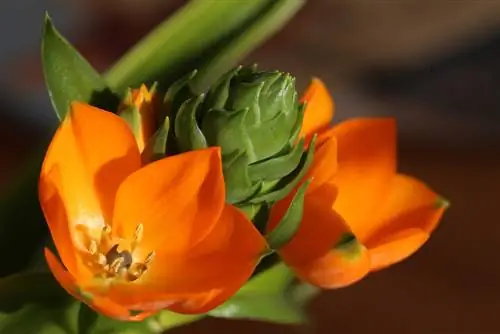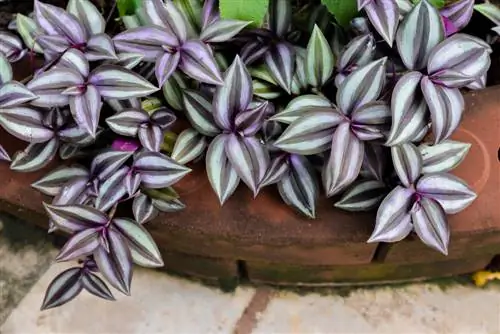- Author admin [email protected].
- Public 2023-12-16 16:46.
- Last modified 2025-06-01 06:02.
Read everything you need to know about the devil's tongue here. You can find out how to use the tuber to lose weight here. How to properly care for Amorphophallus konjac.
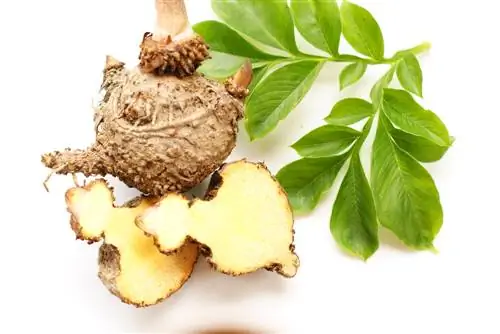
What is the devil's tongue good for?
Devil's tongue (Amorphophallus konjac) is a tuberous plant valued for its satiating and healing properties. It can help with weight loss because it is rich in fiber and binds water. The tuber is often consumed as konjac root flour or used as a powder in capsules.
Profile
- Scientific name: Amorphophallus konjac
- Family: Arum family (Araceae)
- Synonyms: konjac root, tear tree
- Origin: East Asia
- Growth type: tuber
- Effect: satiating, healing
- Growth height: 100 cm to 200 cm
- Leaf: solitary, pinnate
- Flower: spadix with bract
- Flowering period: April to June
- Fruit: Berry
- Winter hardiness: not hardy
tuber
In the first few years, a devil's tongue tuber only produces a majestic leaf with a height and width of 100 to 200 centimeters. This leaf provides the mother tuber with energy for growth and the formation of daughter tubers for reproduction. At the end of the growing season, the leaves die down and the mother tuber rejects its daughter tubers. After a winter rest period of four to five months, a fresh leaf emerges and the tuber begins to multiply again.
This process is repeated over several years until the tuber has a weight of around 500 grams. Until this point, the devil's tongue keeps its ornamental blossom under wraps.
Effect
The tubers of devil's tongue are said to have beneficial effects, as the following short overview shows:
- Reduces body weight
- Quickly filling
- Absorbs fat
- Binds water
- Regulates digestion
- Strengthens the intestinal flora
- Lowers cholesterol levels
- Moisturizes the skin
The beneficial effects on skin diseases, thyroid problems and other diseases are being examined in numerous research projects.
Bloom
After a few years of preparatory work, the adult tuber first produces a flower in spring and then the solitary foliage. The following characteristics characterize a devil's tongue flower:
- Inflorescence: spadix with sessile flowers, covered by a reddish-brown bract
- Size: 55 to 65 cm
- Color: dark purple to brown-red
- Special property: pungent smell of carrion
- Pollination: carrion flies, carrion beetles
At the peak of flowering, the bulb sweats out droplets of liquid. The second name Tear Tree refers to this behavior.
Fruit
As a monoecious, separate-sexual seed plant, the devil's tongue bears male and female flowers in separate areas. The sexes sit on two levels on the piston. Male flowers are located at the top, female flowers develop at the bottom. To prevent self-pollination, male flowers only open when the female flowers have been fertilized from a foreign source or have withered. Consequently, two devil's tongues in close proximity are required for fruit formation. Following pollination, one cob bears orange berries containing one to four seeds.
Devil's tongue for weight loss
Anyone who struggles with extra pounds will appreciate the satiating effect of devil's tongue tubers. The tuberous konjac root is full of glucomannan, a he althy fiber. According to the European Food Safety Authority (EFSA), consuming three grams of konjac root powder daily is enough to shed the pounds. As practical konjac capsules, the satiety powder is immediately at hand for torturous cravings. The following nutritional table proves why Teufelstongue tuber flour is perfect for losing weight:
| Nutritional values | 100 g konjac root flour |
|---|---|
| Calorie | 168 kcal |
| Kilojoules | 704 KJ |
| Fiber | 80g |
| Protein | 2, 0g |
| Carbohydrates | 0 g |
| Sugar | 0 g |
| Energy density | 1, 7 kcal/g |
In the food industry, the tubers are primarily ground into flour. If konjac root flour comes into contact with water, an extreme swelling effect occurs. Processed into rice, noodles, shirataki, konnyaku and other Japanese delicacies, the result is a low-calorie diet that leaves you feeling full and slim. In the EU, konjac flour is known as food additive E425. The knowledge magazine “Gallileo” dedicated this article to the beneficial effects of devil’s tongue tubers:
Video: Superfood devil's tongue tuber
Planting Devil's Tongue
Correct planting of a devil's tongue tuber is primarily aimed at preventing waterlogging. The permeable substrate should still have beneficial water and nutrient storage. The optimal location simulates a tropical rainforest climate. Read all the important details in the following sections. How to properly plant a teardrop tree in a pot:
Substrate
The perfect substrate is a mixture of organically pre-fertilized, peat-free pot plant soil and coconut soil in equal parts, enriched with lava granules or expanded clay. If you have it on hand, add a few more handfuls of nutrient-rich compost soil.
Planting a tuber
Plant a devil's tongue tuber in a deep container with enough space for root growth. With good care, the tubers can triple their weight and volume over the course of the year. The pot should be correspondingly large in diameter. A floor opening for water drainage is essential. How to plant correctly:
- Cover the bottom of the bucket with pottery shards or lava granules as drainage
- Fill in substrate (do not press on)
- Plant the tuber in the middle
- Observe planting depth: three times the tuber diameter
- Pour devil's tongue with soft water
Location
The devil's tongue shows its best side in a partially shaded location with high humidity. From May to September, the tropical rainforest beauty has no objection to a spot on the west or east balcony. This is especially advisable when an adult tuber boasts of its inflorescence, which stinks to high heaven.
Excursus
Titan Arum - Big Brother of the Devil's Tongue
When a titan arum (Amorphophallus titanum) blooms, the news goes viral. Plants all over the world can experience the joy of plants live via a webcam when the largest flower in the world unfolds its smelly bloom, which can be up to three meters tall. The floral spectacle is so rare that meticulous records are kept of every bloom.
Care for Devil's Tongue
So that planting a tear tree does not become a vale of tears for the hobby gardener, it is important to take proper care of it. Don't miss these tips & tricks:
Pouring
Water a devil's tongue with rainwater or stale tap water from spring to autumn. Before each watering, use a finger test to check whether the substrate has dried. Are you not sure whether there is actually a need for watering? Then, if in doubt, spray the mighty leaves with lime-free water.
Fertilize
A supplementary nutrient supply is not necessary. If you follow our care tips, don't cut the devil's tongue and repot it every year, you can avoid adding fertilizer.
Cutting
In autumn, the devil's tongue tuber gradually absorbs its above-ground parts of the plant. Do not intervene in the morbid fading with a pruning. During this process, remaining nutrients from the foliage and inflorescence are transferred to the tuber as an energy reserve for the next year. Remove dead foliage and wilted inflorescences if the remains can be pulled off by hand.
Wintering
After a summer on the partially shaded balcony, please move the exotic devil's tongue to a frost-free location in good time. There are two variants to choose from for wintering. This is how a teardrop tree overwinters properly:
- Putting away: from temperatures below 10° Celsius
- Winter quarters: dark, cool at 8° to 10° Celsius
- Option 1: overwinter in a bucket, do not let the soil dry out completely, do not fertilize
- Rule of thumb: the warmer the devil's tongue overwinters, the wetter the earth
- Option 2: overwinter without soil, similar to dahlia tubers in sand, sawdust or wood shavings, occasionally remove and spray
Wintering in bright, heated living spaces is not recommended. In this variant, the devil's tongue sprouts in winter. In the worst case scenario, the foul-smelling blossom develops when it is far too cold outside to clear out the floral stink.
Propagation
During the winter rest phase, the connection between mother and daughter tubers dries up. The splitting off is complete when you can separate the mother and offshoot without using force or using scissors. Plant the konjac roots in their own pots.
Repotting
The dry winter rest requires repotting every spring, regardless of whether you overwinter the devil's tongue with or without soil. The best time is at the beginning of budding in spring. As a rule, you can reuse the existing planter for the mother tuber after cleaning it. For daughter tubers, please adjust the pot size to the tuber diameter.
Fungal disease
Watering too frequently causes a fungal infection on the fleshy storage organ. As a result of the rot formation, the affected devil's tongue tuber can usually no longer be saved. In the early stages you can cut out fungal, rotten areas. Dust the tuber with disinfectant charcoal powder and let it dry for a few days. Then plant the konjac root in fresh substrate and water more sparingly from now on.
Popular varieties
The devil's tongue is not the only Amorphophallus beauty that impressively presents itself as a potted plant:
- Amorphophallus kiusianus: from southern Japan, yellow-green, light brown spotted bract, green cob, pink berries.
- Amorphophallus bulbifer: from North India, 25 to 30 cm large flowers, pale pink on the outside, yellowish-green on the inside.
- Amorphophallus albus: from China, 15 to 20 cm large, white flowers, bulb up to 10 cm in diameter and 6 cm high.
- Amorphophallus muellerii: from Thailand, up to 2 m tall, purple flower, creamy white bulb, 30 cm large tuber.
FAQ
How to use konjac capsules for weight loss?
The capsules contain the flour of a konjac root. This natural powder has the ability to absorb a lot of water and swell significantly. For this reason, you will feel optimally full after taking it. In conjunction with a low-calorie diet, Konjac capsules make a valuable contribution to weight loss. Experts recommend a dosage of 2 capsules 3 times daily before meals. Ideally, drink one or two glasses of water.
The tuber becomes mushy during overwintering. What to do?
The damage described indicates a fungal infection. Particularly during the winter dormant phase, the fungus causes the spread of rot on the fleshy tubers. You can attempt a rescue. Cut out any mushy spots from the tuber. Disinfect the cuts with charcoal powder or rock dust and let the konjac root dry for two to three days. Repot the devil's tongue in dry substrate.
How does devil's tongue propagation work with seeds?
Place the freshest possible seeds about one centimeter deep in coconut soil. Slightly moisten the substrate and ideally place a transparent hood over the seed container. The ideal sowing temperature is 25° to 28° Celsius during the day and around 20° Celsius at night. A bright to partially shaded location will help the first seedlings develop within two to six weeks.


